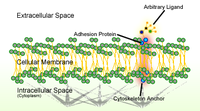
Photo from wikipedia
Endothelial dysfunction is a common disorder of vascular homeostasis in hypertension characterized by oxidative stress, malignant migration, inflammatory response, and active adhesion response of endothelial cells. The extracellular vesicles (EVs),… Click to show full abstract
Endothelial dysfunction is a common disorder of vascular homeostasis in hypertension characterized by oxidative stress, malignant migration, inflammatory response, and active adhesion response of endothelial cells. The extracellular vesicles (EVs), a vital participant in vascular cell communication, have been considered responsible for vascular disease progression. However, the potential mechanism of antihypertensive peptides against the EVs-induced endothelial dysfunction is still unclear. In this study, we investigated whether the antihypertensive peptides Val-Pro-Pro (VPP) and Ile-Pro-Pro (IPP) ameliorate the effects of EVs from Ang II-induced vascular smooth muscles (VSMCs) on the endothelial dysfunction. The dihydroethidium staining, wound healing assay, 3D cell culture, and co-culture with U937 monocyte were used to investigate the oxidant/antioxidant balance, migration, tube formation, and cell adhesion in EV-induced human umbilical vein endothelial cells. VPP and IPP treatment reduced the level of reactive oxygen species and EV-induced expression of adhesion molecules and restored the ability of tube formation by upregulating endothelial nitric oxide synthase expression. VPP and IPP reduced the protein levels of IL-6 to 227.34 ± 10.56 and 273.84 ± 22.28 pg/mL, of IL-1β protein to 131.56 ± 23.18 and 221.14 ± 13.8 pg/mL, and of MCP-1 to 301.48 ± 19.75 and 428.68 ± 9.59 pg/mL. These results suggested that the VPP and IPP are potential agents that can improve the endothelial dysfunction caused by EVs from Ang II-induced VSMCs.
Journal Title: Journal of agricultural and food chemistry
Year Published: 2020
Link to full text (if available)
Share on Social Media: Sign Up to like & get
recommendations!